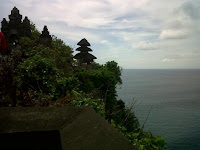Uluwatu Temple is located at Pecatu Village, South Kuta Sub-district, Badung Regency. The temple has an appeal because the scenery around this temple is very intriguing. The temple is built at the edge of high and steep rock which juts into the sea and a height about 70 meters. From this temple we can enjoy beatiful sunset. The main purpose of tourists come here to see the beauty of sunset, kecak dance, and uniqueness of the temple.
 Uluwatu Temple have function as a place to worship the God Rudra. Uluwatu Temple is believed by Hindus as a buffer of 9 wind direction or so-called " Sad Kahyangan " temple. According to history, the temple was built at the instigation of Mpu Kuturan around the eleventh century, as a place to bring down the teachings of traditional village with all the rules, and then the temple used to worship by a holy priest that named Dang Hyang Nirartha, a holy priest from Java, come to spread the teachings of Hinduism in 1546 AD, during the reign of Dalem Waturenggong King in Gelgel Kingdom.
Uluwatu Temple have function as a place to worship the God Rudra. Uluwatu Temple is believed by Hindus as a buffer of 9 wind direction or so-called " Sad Kahyangan " temple. According to history, the temple was built at the instigation of Mpu Kuturan around the eleventh century, as a place to bring down the teachings of traditional village with all the rules, and then the temple used to worship by a holy priest that named Dang Hyang Nirartha, a holy priest from Java, come to spread the teachings of Hinduism in 1546 AD, during the reign of Dalem Waturenggong King in Gelgel Kingdom.
Uluwatu Temple is one of popular tourism object and become a mandatory destination during your visit in Bali. At the temple area there is a stage where Kecak Dance performance is held every afternoon, with background of beautiful sunset makes it a spectacular show, with accompanied by a group of dancers numbering about 50 men. If you are holidays in Bali, take your time to enjoy the sunset at Uluwatu with Kecak Dance entertainment.





